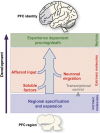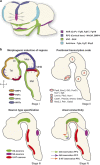Molecular underpinnings of prefrontal cortex development in rodents provide insights into the etiology of neurodevelopmental disorders
- PMID: 25450230
- PMCID: PMC4486649
- DOI: 10.1038/mp.2014.147
Molecular underpinnings of prefrontal cortex development in rodents provide insights into the etiology of neurodevelopmental disorders
Abstract
The prefrontal cortex (PFC), seat of the highest-order cognitive functions, constitutes a conglomerate of highly specialized brain areas and has been implicated to have a role in the onset and installation of various neurodevelopmental disorders. The development of a properly functioning PFC is directed by transcription factors, guidance cues and other regulatory molecules and requires the intricate and temporal orchestration of a number of developmental processes. Disturbance or failure of any of these processes causing neurodevelopmental abnormalities within the PFC may contribute to several of the cognitive deficits seen in patients with neurodevelopmental disorders. In this review, we elaborate on the specific processes underlying prefrontal development, such as induction and patterning of the prefrontal area, proliferation, migration and axonal guidance of medial prefrontal progenitors, and their eventual efferent and afferent connections. We furthermore integrate for the first time the available knowledge from genome-wide studies that have revealed genes linked to neurodevelopmental disorders with experimental molecular evidence in rodents. The integrated data suggest that the pathogenic variants in the neurodevelopmental disorder-associated genes induce prefrontal cytoarchitectonical impairments. This enhances our understanding of the molecular mechanisms of prefrontal (mis)development underlying the four major neurodevelopmental disorders in humans, that is, intellectual disability, autism spectrum disorders, attention deficit hyperactivity disorder and schizophrenia, and may thus provide clues for the development of novel therapies.
Figures



References
-
- Belfer ML. Child and adolescent mental disorders: the magnitude of the problem across the globe. J Child Psychol Psychiatry. 2008;49:226–236. - PubMed
-
- Mitchell SR, Reiss AL, Tatusko DH, Ikuta I, Kazmerski DB, Botti JA, et al. Neuroanatomic alterations and social and communication deficits in monozygotic twins discordant for autism disorder. Am J Psychiatry. 2009;166:917–925. - PubMed
Publication types
MeSH terms
LinkOut - more resources
Full Text Sources
Other Literature Sources
Miscellaneous

